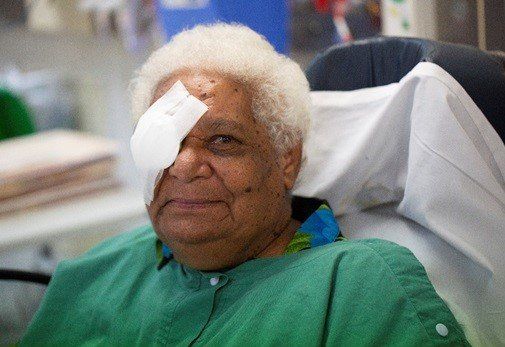Ian Wishart is the CEO of The Fred Hollows Foundation. Fred Hollows’ original mission to improve the health of Aboriginal and Torres Strait Islander Peoples lives on in the work we do. The Fred Hollows Foundation’s Board and staff have supported the Uluru Statement from the Heart since it was first shared. We have accepted the invitation of the Uluru Statement from the Heart to walk alongside Aboriginal and Torres Strait Islander Peoples for a better future.
Reform the Answer to Giving Indigenous Australians a Voice
The Fred Hollows Foundation supports the Uluru Statement from the Heart and its call for a constitutionally enshrined First Nations Voice to Parliament.

After almost five years of delay, media reports suggest the Australian Government will release its final report on the Indigenous Voice codesign process before the end of the year. Reports claim the Government plans to push through a legislated Voice model before the next election.
This may appear to be action, but for most Aboriginal and Torres Strait Islander Peoples it’s a classic wedge. The model proposed goes against their direct wishes as set out in the Uluru Statement from the Heart. They respectfully asked for a constitutionally-enshrined First Nations Voice to Parliament and they are being told what is best for them is something else. A constitutional solution was called for to prevent exactly this kind of condescension.
The Uluru Statement from the Heart was delivered in 2017. It was based on an extraordinary and unprecedented consultation process undertaken by the Referendum Council, which included 13 Regional Dialogues and the first National Constitutional Convention convened by, with and for Aboriginal and Torres Strait Islander Peoples. It reflects the consensus reached on what meaningful constitutional change looks like for Aboriginal and Torres Strait Islander Peoples.
A constitutionally-enshrined Voice to Parliament is the only form of constitutional change that has wide and broad support from Aboriginal and Torres Strait Islander Peoples.
Any move by the Morrison Government to rush legislation through Parliament, when no one has seen the final recommendations of the report, goes directly against Aboriginal and Torres Strait Islander Peoples’ right to self-determination. It also goes against the Government-appointed Joint Select Committee on Constitutional Recognition relating to Aboriginal and Torres Strait Islander Peoples 2018, which recommended the Government “consider, in a deliberate and timely manner, legislative, executive and constitutional options to establish The Voice”.
There is nothing timely about this process and there is nothing deliberate about this process. Rushing legislation before Aboriginal and Torres Strait Islander Peoples have even seen it is not timely, its disrespectful. Dismissing the constitutional option out of hand in 2017, as former Prime Minister Malcolm Turnbull did, was not deliberative it was insulting. Then excluding constitutional enshrinement from the Terms of Reference of the current codesign process was yet another manipulation.

Photo credit: Michael Amendolia.
A constitutionally-enshrined First Nations Voice is critical, as this will ensure that it cannot be abolished by governments if priorities change or they don’t like its advice. Unfortunately, the Australian Government has a track record of defunding and dismantling legislated First Nations Voices. In 2004 Prime Minister John Howard abolished the Aboriginal and Torres Strait Islander Commission, which was set up to advise governments on Aboriginal and Torres Strait Islander Affairs. In 2013, Prime Minister Tony Abbott defunded the National Congress of Australia’s First Peoples, which was a national representative body.
With history as our guide, a constitutional Voice is the only option that will deliver the authority and certainty required for a durable First Nations Voice on laws and policies which affect Aboriginal and Torres Strait Islander Peoples.
All people have a right to be involved in decisions that affect them. A constitutionally-enshrined Voice to Parliament would finally ensure that Aboriginal and Torres Strait Islander Peoples are heard and can make decisions about their lives. Aboriginal and Torres Strait Islander Peoples know what is best for their communities. A constitutionally-enshrined Voice to Parliament would make our nation stronger, and it would create a more equal society for everyone. It is a fair and practical reform that will lead to better policies and outcomes for First Nations Peoples.
Aboriginal and Torres Strait Islander Peoples deserve far better than rushed legislation that goes against their express wishes. We need this Government to commit to calling a constitutional referendum in the next term of Parliament, if reelected. Labor has committed to implementing the calls of the Uluru Statement from the Heart in full if it is elected. But we also need a concrete commitment from them that, if elected, they will call a referendum in the next term of Parliament.
Polls consistently show that most Australians support a constitutionally-enshrined Voice to Parliament, and the right of Aboriginal and Torres Strait Islander Peoples to have a say over the matters that affect them. We need Australians to be loud about their support now. Talk to your friends and family about why you support the Statement. Write to your MP. Get your organisation to make a public statement of support.
Together we can make this happen.











